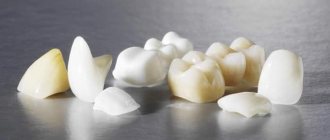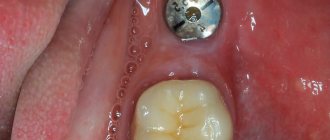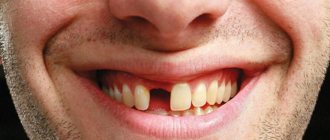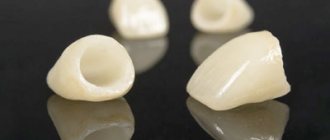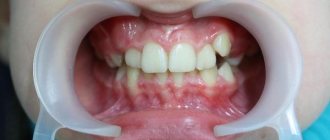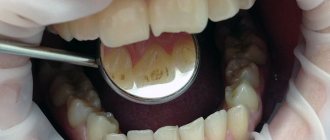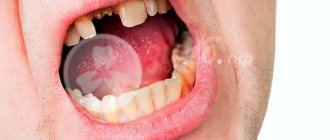Metal-free crowns are orthopedic structures for restoring the integrity of the coronal part of the tooth. Metal is not used in such products; modern materials are used - lithium disilicate (ceramics), zirconium dioxide, aluminum oxide. The products are durable, biocompatible, hypoallergenic, aesthetic. The service life is more than 15 years. The cost depends on the material and manufacturing technology.
E.Max ceramic crowns and veneers
Attending doctor
Strigin Vladimir Igorevich
Find out the price
Types of materials
Lithium disilicate (E-max ceramic crown)
Our Center installs 2 types of ceramic crowns made of lithium disilicate (glass ceramics). They differ in indications and manufacturing technologies:
- E-max PRESS - available in the form of pressed “tablets”. Orthopedic products are made from it under the influence of high temperatures and pressure. The strength of the material reaches 400 MPa. Suitable for making single crowns and bridges up to 3 teeth in the area of the front teeth. Classic Emax PRESS monochromatic, transparent, inexpensive. A frame is made from it, onto which layers of liquid porcelain and dyes are applied to give the structure a natural shade. We use the improved E-max PRESS Multi, it is more expensive, but has a gradient of color and transparency, so it does not require porcelain coating.
- E-max CAD - lithium disilicate blocks for the manufacture of orthopedic structures on a milling machine under software control using CAD/CAM technology. The material is more durable - up to 450 mPa, can be used for chewing units of the dentition. Robotic production eliminates the human factor, ensures an accurate fit, and eliminates adjustments. The technology makes it possible to produce thin products, so minimal grinding of teeth is required. Coloring the material with a smooth transition of shades from more saturated to transparent allows you to imitate tooth enamel.
Based on zirconium dioxide (zirconium crown)
Products based on zirconium oxide are manufactured by milling using CAD/CAM technology and have a thickness of up to 0.4 mm. The material has properties close to natural tooth enamel and has good light transmission characteristics. It gives the impression of a smooth exit of the tooth unit from the gums - at the exit in the center of the crown the color is saturated, and on the sides and at the cutting edge it is more transparent. Zirconium structures are hypoallergenic and suitable for people suffering from allergic reactions. Crowns rank first in terms of strength (up to 1200 mPa), which allows them to be installed in place of the front and chewing teeth and used in bridges of any length. Strength, biological compatibility, and high aesthetics have made zirconium dioxide a popular material. The only negative is the high cost.
Made from aluminum oxide (Procera technology)
Aluminum oxide is a translucent mineral that belongs to metal-free ceramics. Crowns made from it are less durable than zirconium, but stronger than E-max ceramics. This is enough for installation on the front and chewing teeth, making reliable bridges of different lengths. Aluminum oxide transmits light, is resistant to deformation, biocompatible, hypoallergenic. The aluminum oxide frame is manufactured using CAD/CAM technology in several stages after creating a virtual model of the product. Procera® technology from Nobel Biocare, a leader in the field of metal-free restorations in terms of aesthetic and quality characteristics, is used for production. Crowns are manufactured in a factory in the USA. The cost of products is the highest, as it includes shipping costs.
Temporary plastic crowns can also be classified as non-metal crowns. They are installed during the production of permanent teeth to protect ground teeth and to correct the bite during multiple restorations. Easy to manufacture, inexpensive. But they are not intended for long-term wear - they quickly absorb food coloring and cannot withstand constant chewing loads.
CL-II (glass ceramics)
The materials used in the manufacture of prostheses for this group are similar to the previous ones in their composition. But the main differences are their processing methods and structure. Glass ceramics are characterized by adding crystals to glass or growing them in it. If CL-I group crowns are made manually, then CL-II ceramics are supplied in special blocks.
Glass ceramics are divided into two types:
- CL-IIa. The composition contains a small amount of leucite-feldspathic glass (up to 50%). When the feldspar level is low, the crown material is transparent, so an additional procedure (bonding) is required during preparation. Glass ceramics are used for the same purposes as the ceramic mass of the CL-I group. Their service life is quite long. When using prosthetics, the minimum layer must be at least 0.8 mm. The main advantage is durability. This is achieved due to changes in the coefficient of thermal expansion of leucite, which significantly reduces the risk of cracks in the crown during operation.
- CL-IIb. In the ceramics of this group, the content of leucite-feldspar glass is higher than average (more than 50%). The blanks are made of glass, so they are completely transparent. The next step is growing the crystals, then grinding them and applying them to the first phase (glass). Due to this, greater strength of the material is achieved, since such processing allows the formation of an area of compressive stress. Basically, lithium disilicate (from silica), lithium dioxide, aluminum and potassium oxides, and phosphorus pentoxide are used for the manufacture of prostheses. Not long ago, lithium disilicate reinforced with zirconium (up to 10%) began to be used in prosthetics. The main advantage of this material is its durability and the possibility of performing a single restoration of any tooth.
Advantages and disadvantages
Advantages of metal-free structures:
- biological compatibility, hypoallergenic, metal-free;
- absence of a “gray neck” at the gums, characteristic of metal-ceramics;
- light transmittance, increasing the aesthetics of the product;
- lightness, the ability to install even on weakened teeth;
- absence of strong grinding and depulpation of the tooth;
- no sensitivity to temperature changes;
- preservation of natural shade for a long time;
- service life more than 15 years;
- tight fit to the gum.
The only negative is the high price compared to metal-ceramics, which is compensated by the listed advantages.
Features of prosthetics
Installation of the structure requires a specialist’s painstaking work and care. It provides for the gradual implementation of professional manipulations.
Stages of installation of an orthopedic model:
- First, the doctor preliminarily examines the oral cavity. If there is any inflammation or carious process here, it treats the existing pathology.
- Preparation for work involves examining the tooth being treated and grinding down excess areas (if required).
- Making an impression of the dentition: a product is created from it.
- Installation of a temporary plastic structure. This is necessary to provide the oral cavity with the required aesthetics.
- Selecting the appropriate shade of crowns. This procedure requires careful attention from a specialist. Otherwise, the wrong color will stand out noticeably.
- Installation of the finished model. To fix it, a special composition is used that is not destroyed under the influence of negative factors.
In order for a metal-free structure to serve for a long time and not create problems, it must be installed by an experienced specialist.
Indications
- Prosthetics for the first time. If the supporting teeth are strong and healthy, there is no need to depulpate them or sharpen them much. Metal-free products allow you to preserve “living” teeth.
- Replacement of outdated structures. Recently, patients are increasingly seeking to improve aesthetics and quality of life, so they turn to us to replace outdated metal-ceramic crowns.
- Allergy to metal. If metal or metal-ceramic crowns cause discomfort, metal-free crowns are the only option.
- Increased requirements for aesthetics. When a patient requires dentures that are indistinguishable from natural teeth, only a metal-free design is suitable.
- Weak supporting teeth. Metal-free products are lightweight and do not create an increased load on the teeth.
Crown care
There are no special requirements for caring for these structures; you just need to maintain oral hygiene and care for them in the same way as regular teeth. Brush your teeth daily using a brush and low-abrasive toothpaste, removing food debris from the crown-gum junction and from between teeth. After eating, you should use special rinses or simply rinse your mouth with water. Dental floss will help remove particles from between spaces. Avoid chewing on hard objects—nuts and seeds can harm your new teeth. If you follow all the recommendations, the service life of the crowns can be significantly increased.
Technologies and manufacturing stages
We give preference to crowns made in 2 ways:
- Milling (CAD/CAM technologies). For manufacturing, the doctor scans the patient’s oral cavity (CAD), digital data is transferred to a computer, where a 3D model is recreated in a special program. The information is transmitted to milling equipment (CAM) to obtain the desired shape from the blanks. This is the main method used in our Center.
- Pressing (used for E-max technology). High pressure and temperature are used to shape the material. The crown is made using a wax structure. It is used less frequently, but is also used at the request of the patient.
Installation
Examination, preparation of the oral cavity
The dentist assesses the patient's condition. If necessary, an x-ray is taken, caries is treated, non-viable units are removed, and professional cleaning is carried out.
Tooth preparation
Gentle grinding is carried out to the thickness of the crown, only the affected tissue is removed. Severely damaged units are strengthened with stump inlays. If necessary, temporary plastic prostheses are installed to protect against destruction while the structures are being prepared.
Taking impressions
It is carried out using impression material or scanning the oral cavity with a camera.
Making a crown
In the laboratory, based on the models, prostheses are made by pressing or milling.
Fitting and correction
The prosthesis is tried on to assess its comfort and fit. If necessary, the crown is sent to the laboratory for final work to adjust the shape of the product.
Installation
The finished prosthesis is attached to the tooth using dental cement for fixation.
After 4-7 days, the patient is scheduled for a follow-up visit for examination and prevention of complications. The entire installation process, taking into account the preparation of the oral cavity, takes from 2 weeks to 2 months, depending on the complexity of the case.
In difficult situations, when restoration of a large number of teeth is required, as well as for doubtful patients, the design of future crowns is first selected and approved:
- First, wax modeling of future structures is carried out on models of the patient’s jaws (Wax-up). You can see your future smile even before the start of prosthetics and make the necessary wishes for adjustments.
- Then the resulting modeled crowns are transferred into the oral cavity in the form of temporary test products (Mock-up), without grinding the teeth. You can evaluate the functionality and check the wearing comfort before starting the main prosthetic work.
How are crowns made?
To replace a tooth, you need to have a crown made in a medical clinic. To do this, there are three stages:
- the doctor, in the office, makes a cast of the jaw so that the position is clear, and transfers it to the laboratory;
- the equipment scans the impression and creates a model required for specific teeth;
- The implant is automatically made from the necessary materials.
Some clinics use more modern equipment to work with teeth. Which? An intraoral scanner, with which you can avoid using impression material, that is, skip the first step of working with teeth when making new bridges.
Prices
Our Center has developed prices for cases for the installation and production of metal-free crowns. The cost depends on the technology and material, includes:
- manufacturing;
- fittings;
- fixation.
Case prices for products using digital CAD/CAM technologies:
- ceramic crown E.max - 36,000-48,000 rub.
- crown made of zirconium dioxide - 38,000 rubles.
- ceramic crown on a zirconium dioxide frame - 42,000-58,000 rubles.
Lithium disilicate and zirconium dioxide crowns have fixed prices, as they are manufactured in our own laboratory using ZirkonZahn® technology. Prices for aluminum oxide crowns using Procera® technology may vary slightly depending on the ruble exchange rate.
Impressions are paid separately - 3,500 rubles. The price does not depend on the method of obtaining them (impression mass or digital scanning).
In non-standard situations, an individual crown design is required, which is paid separately:
- manual wax modeling Wax-up - RUB 1,600. for 1 unit;
- temporary plastic crowns or Mock-up - RUB 6,000. for 1 unit.
Disadvantages of E-max –
- High cost - compared to standard metal ceramics (but at the same time it is comparable to the cost of highly aesthetic metal ceramics with “shoulder mass”),
- not on chewing teeth (on 6-7-8),
- not allowed with bruxism,
- it is impossible if the stump of the ground tooth is dark in color,
- it is not advisable if there are a large number of missing teeth (in this case, the entire chewing load is not distributed evenly, but only on the remaining teeth, leading to their overload). We hope that our article on the topic: E-max metal-free ceramic crown, price, reviews was useful to you!
Sources :
1. Personal experience as a dentist, 2. National Library of Medicine (USA), 3. Harvard Medical School (USA), 4. https://www.ivoclarvivadent.us/, 5. https://www .realself.com/, 6. “Crowns and bridges in prosthetic dentistry” (Smith B.).
Our prices are a guarantee of high quality
Case pricing adopted in our Center may at first seem more expensive than in other clinics. But we use only high-quality materials and never purchase Chinese fakes. In addition, our system is honest - we indicate in advance all possible additional costs, do not hide anything, and do not put patients in an uncomfortable situation when drawing up the final estimate.
Levin Dmitry Valerievich
Chief physician, Ph.D.
Why do you need dentures?
Damaged teeth, and not only in the smile area, need to be replaced with prosthetics, and the sooner the better. Lost interdental contacts, changes in bite, tilt and displacement of neighboring teeth are only part of the problems that await a person who postpones the restoration of lost or damaged teeth for at least a year. We talk about this in detail in the section Fixed prosthetics.
In addition, solving problems that arise later will be significantly more expensive, so dentists recommend not to put off such treatment “on the back burner.”
Life time
The average service life of metal-free prostheses is 15 years. With proper care they will last longer. The timing depends on the chosen material and location in the dentition. It is of great importance how much the patient complies with the doctor’s instructions for the care of the structure and diet.
In our Center for Private Dentistry “Doctor Levin” there is a guarantee for the integrity and color of metal-free crowns made using digital technology for 25 years. Our orthopedists are confident in their work and the quality of the source material. The warranty periods are confirmed by digital passports for the products.
Indications and contraindications for prosthetics
The installation of metal-free crowns and bridges is recommended in the same cases as prosthetics with bimetallic or metal-ceramic structures. Therefore, the main indications for prosthetics with porcelain and zirconium products are as follows:
- severe tooth decay: 2/3 of the height or ½ of the chewing surface or cutting edge;
- absence of one or more units;
- correction of wedge-shaped defects and other non-carious lesions;
- chips and fractures of the tooth crown;
- visual elimination of the curvature of the dentition.
In addition to general indications, there are specific ones. These include cases when it is impossible to install bimetallic crowns on teeth. This:
- Allergy to metal alloys. For patients with hypersensitivity, metal-free bridges and crowns are the only prosthetic option.
- High demands on the aesthetics of artificial crowns. The average person cannot distinguish ceramics and zirconium oxide from natural teeth, while structures made of bimetals are noticeable to outsiders. Even ceramic coating does not help - the metal frame is visible through the cladding.
Metal-free ceramics are an ideal option for prosthetics of anterior teeth
. There are also contraindications:
- pregnancy and lactation;
- systemic diseases of the body in the acute stage;
- osteoporosis;
- inflammatory pathologies of the oral mucosa;
- serious defects of the maxillofacial area - deep and open bite, dysfunction of the temporomandibular joint.
Dentures are also not advisable for bruxism - involuntary grinding of teeth during sleep. However, the disease is not considered an absolute contraindication - dentists make mouth guards that will protect the crowns from abrasion at night. Plus, the management of the clinic does not provide a guarantee for prostheses to such patients.
To install a metal-free crown, less hard tissue is ground down than for a metal-ceramic crown.
What is better for the front and chewing teeth?
When choosing a type of orthopedic design, the location of the tooth to be restored is taken into account:
- E-max glass ceramics are suitable for the front ones, as it allows you to achieve a natural shade of enamel;
- It is better to make dentures for molars from zirconium dioxide, which is characterized by increased strength;
- for increased demands on aesthetics, E-max Multi with gradient coloring or translucent crowns made of zirconium or aluminum oxide are suitable;
- For prostheses on implants, only zirconium is recommended for bruxism.
The recommendations described are based on the different requirements for dentures for anterior and chewing teeth. For the former, aesthetics are more important, for the latter - strength and wear resistance.
Sometimes you have to choose from all three options to decide which one is right for your specific situation. The light transmitting characteristics of materials depend on the original color and transparency of your teeth. Fittings are free, but they take time, so you need to plan prosthetics at a time when you can visit the clinic without affecting your business.
A few words about the restoration of ceramic crowns
Despite the fact that metal-free ceramics is the leader in strength among all other types of prostheses, it is susceptible to defects. As a rule, the causes of chips include: injury from a fall or impact; malocclusion; unprofessional work of a prosthetist dentist; excessive chewing load.
If one of the above reasons occurs, and the ceramic crowns installed on the front teeth or in the chewing area have been destroyed, it is necessary to restore them. In some cases, a complete replacement of such prostheses is required, which involves removing the crown from the oral cavity. Next, the entire prosthetic procedure is repeated, at the end of which the new crown is fixed.
If metal-free ceramics installed on the front teeth are being restored, the chip is initially polished to the required shape using a light-composite material. In this case, a prerequisite is to grind the irregularities to the required size.
Restoration, which allows you to restore ceramic crowns on the front teeth, has positive reviews. This is due to the affordable cost of the procedure and the minimum time it takes to complete it. In most cases, the entire process takes about 50-60 minutes.
However, even if a specialist has solid experience and uses high-quality materials, a new ceramic crown for a tooth, the price of which exceeds the cost of restoration, is the most priority option.
The difference between a metal-ceramic crown and non-metal ceramics
Metal-ceramic crowns have been used in orthopedics for more than 35 years. They consist of a frame based on an alloy of chromium with cobalt or nickel and a ceramic coating. The products are durable, can withstand heavy loads, and last more than 10 years. But compared to metal-free products, metal ceramics have a number of disadvantages:
- mandatory depulpation and grinding of the tooth before installation;
- possibility of allergy to metal;
- the risk of gum subsidence and exposure of the metal base;
- chips of ceramics are possible;
- poor light transmission, which makes the prosthesis look unnatural.
In our Center, after switching to digital milling in 2000, we completely abandoned metal-ceramics in favor of metal-free products.
Group CL-I (powder/liquid)
These types of ceramics in dentistry consist of powdery and liquid materials. Their main component is silicon dioxide, which is contained in the glassy mass. Depending on the ratio of these components, the crown will have a more or less pronounced crystalline structure.
The CL-I group includes:
- Creation Porcelain, Jensen Dental;
- Ceramco 3, DENTSPLY International;
- EX-3, Kuraray Noritake Dental, Inc.
Dentures can also be made from feldspar, which contains barium, potassium, calcium or sodium. Initially, dental crowns were made from this material.
Options for aluminosilicates used:
- VITA VM 13, VITA Zahnfabrik;
- Vintage Halo, Shofu.
The production of prostheses of the CL-I group is carried out manually. They are used primarily for restorations that preserve most of the tooth, since the material is quite fragile and transparent. Nevertheless, it is feldspars that make it possible to achieve the best results when correcting the structure of a damaged crown.
Aluminosilicates are applied to the enamel in a thin layer of 0.2−0.3 mm. As a rule, ceramics from the CL-I group are used to restore incisors and canines, and less commonly, molars and premolars. Although the ceramic mass used for teeth is quite fragile, under adequate load the probability of its damage is very low.
